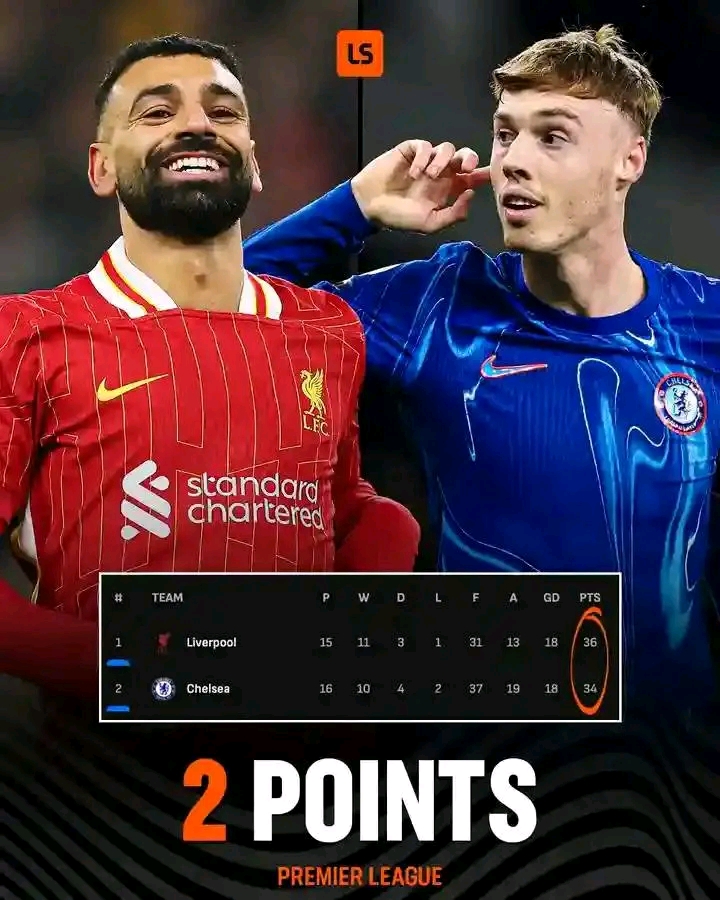
Top notch: Struggles! Points between the 𝐭𝐨𝐩 𝐭𝐰𝐨 across Europe’s big leagues…
The race for supremacy across Europe’s top football leagues has reached fever pitch, with the gap between the top two teams in several competitions becoming razor-thin.
In leagues renowned for their competitiveness, such as the Premier League, La Liga, Serie A, Bundesliga, and Ligue 1, the margin for error has never been smaller. These battles highlight the intense competition, strategic maneuvers, and relentless pursuit of glory that define the beautiful game.
Premier League: A Tactical Chess Match
The Premier League continues to live up to its reputation as one of the most competitive leagues in the world. Manchester City and Arsenal have been locked in an enthralling battle for supremacy.
Defending champions City, led by Pep Guardiola, rely on their fluid possession-based play, while Arsenal, rejuvenated under Mikel Arteta, have emerged as a serious contender with youthful exuberance and tactical discipline.
Despite City’s dominance in recent years, Arsenal’s high-pressing game and attacking flair have proven a formidable challenge.
Matches against mid-table sides have become critical, with dropped points in unexpected fixtures often deciding the title. The razor-thin gap between these two titans keeps fans and pundits alike on edge as every game feels like a final.
La Liga: A Revival of Old Rivalries
In Spain, the eternal rivalry between Barcelona and Real Madrid is taking center stage once again. Xavi’s Barcelona, riding on defensive solidity and young stars like Pedri and Gavi, has managed to reinvigorate its fanbase after recent struggles. Meanwhile, Carlo Ancelotti’s Real Madrid, powered by veterans like Luka Modrić and Karim Benzema, combines experience with emerging talents like Jude Bellingham.
The struggle for dominance often shifts with each El Clásico, but what’s more critical is the ability to grind out results against lower-tier teams. Real Madrid’s knack for late goals contrasts with Barcelona’s tendency to control games through possession. The narrow points gap ensures the title race remains wide open, with neither team affording the luxury of complacency.
Italy’s Serie A has seen a dramatic shift in power dynamics over the past few seasons. Napoli, rejuvenated under a modernized approach, clinched the title last season but now face stiff competition from traditional powerhouses like Inter Milan and Juventus. The top two often exchange places, with Napoli’s fluid attacking game clashing against Inter’s physicality and Juventus’ methodical pragmatism.
In a league where a single goal can often define the outcome of a match, the battle for supremacy is as much mental as it is physical. The narrow points gap at the top reflects this, with Napoli needing to adapt to being the team to beat, while Inter and Juventus leverage their experience in handling title races.
Bundesliga: Bayern Munich’s Relentless Pursuit
The Bundesliga has traditionally been Bayern Munich’s playground, but Borussia Dortmund and, more recently, RB Leipzig have managed to disrupt that narrative.
While Bayern’s dominance persists, thanks to their star-studded lineup and depth, Dortmund’s youthful energy and Leipzig’s counterattacking prowess have made the title race far more intriguing.
Dortmund, in particular, has struggled to maintain consistency in crucial matches, allowing Bayern to capitalize on their experience and ability to win under pressure.
Yet, the gap between the top two remains narrow, with Bayern’s occasional slip-ups providing hope for their challengers.
Ligue 1: Paris Saint-Germain’s Crown Under Threat
In France, Paris Saint-Germain has ruled the roost for over a decade, but teams like Lens and Marseille are now mounting serious challenges.
PSG’s dominance, built on superstars like Kylian Mbappé, Neymar, and Lionel Messi (before his departure), has been questioned as they face spirited resistance from their domestic rivals.
Lens’ rise has been particularly noteworthy, with the team relying on collective unity, pressing football, and a strong home record to close the gap.
The difference between PSG and their challengers often boils down to consistency; while PSG can overwhelm teams with individual brilliance, Lens and Marseille rely on cohesive systems to stay competitive.
Factors Influencing Tight Races
1. Squad Depth: Injuries to key players often disrupt campaigns, making depth a critical factor. Teams with well-rounded squads are better equipped to handle the pressure.
2. Consistency: Winning matches against mid- and lower-table teams remains the hallmark of champions. Dropped points in such fixtures have often been the difference in tight races.
3. Tactical Adaptability: Managers who can adjust tactics mid-season or mid-game often give their teams the edge in crucial moments.
4. Mental Strength: Handling the psychological strain of a tight title race can define outcomes, especially in leagues where rivalries intensify the stakes.
The struggles between the top two teams in Europe’s big leagues underline the incredible competitiveness of modern football.
Margins are slimmer than ever, and the importance of every game, goal, and decision has been amplified. While dominant forces like Manchester City, PSG, and Bayern Munich remain, the rise of challengers like Arsenal, Lens, and Dortmund ensures unpredictability remains a core feature of the sport.
Fans around the world eagerly watch as these fierce battles unfold, knowing that the smallest detail could determine the fate of their favorite teams.
As the season progresses, the drama, passion, and unpredictability of football continue to captivate millions.







